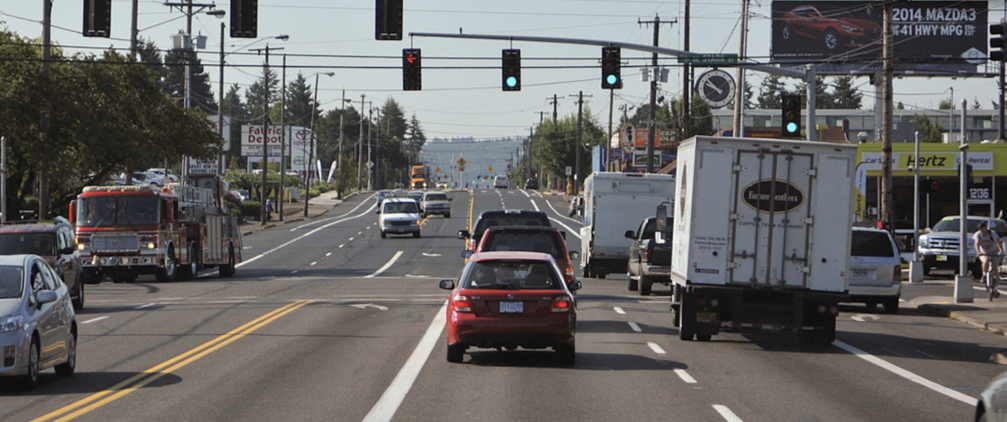
(Photo: Jonathan Maus)
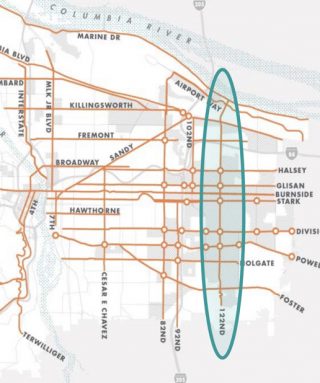
The next evolution of 122nd Avenue has begun.
A new planning effort by the City of Portland Bureau of Transportation has the ambitious goal of removing the north-south arterial from the official high crash network.
I say ambitious, because 122nd is arguably the most dangerous street in Portland. It has the dubious distinction of being home to four of the top ten most dangerous intersections and it’s one of only 13 streets citywide that’s earned a “high crash” designation for bikers, walkers, and drivers.
But if all goes according to plan, in just two years 122nd will have a much different reputation.
If that timeline seems optimistic, bear in mind that efforts to improve 122nd Avenue have already begun. In the past three years, PBOT has pumped $4 million into safety upgrades into the street — just half of an $8 million agreement with TriMet wherein the transit agency’s end of the bargain is to implement a frequent service bus line. With the announcement last month that Line 73 will now run every 15 minutes or less, that’s a promise they’ve already made good on.
Advertisement
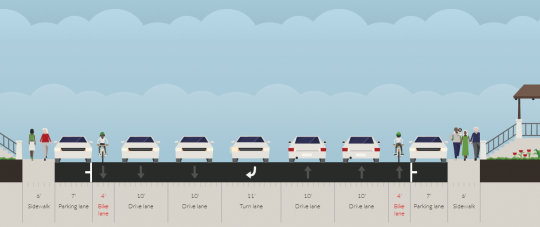
(Image: Streetmix.net)
PBOT has also placed 38 high-tech traffic sensors on 122nd between Burnside and Bush. That project will help PBOT better understand how people are behaving on the street and will inform which interventions are most likely to improve them.
In addition to the funding that’s part of the TriMet partnership, PBOT has set aside $2 million from the new local gas tax to design and build safety projects on 122nd. This new plan will aim to prioritize not just how that $2 million should be spent; but also which projects should be built when future funding becomes available.
Among the changes we could see on 122nd are a lane reconfiguration from the existing five standard lane cross-section, to a more modern and humane alignment that includes fewer lanes for driving and more dedicated lanes for bikes and buses. (Line 73 is one of only two bus lines specifically identified for improvements in the City’s recently adopted Enhanced Transit Corridor plan.)
Along with a new project website, PBOT has released an online survey (open through August 15th) to get a better sense of how the public feels about the street. An open house this fall will share design concepts and potential projects. Once plans are finalized, PBOT expects to design and build out the project in 2019-2020.
For more information, contact PBOT Project Manager April Bertelsen via email at april.bertelsen@portlandoregon.gov.
— Jonathan Maus: (503) 706-8804, @jonathan_maus on Twitter and jonathan@bikeportland.org
Never miss a story. Sign-up for the daily BP Headlines email.
BikePortland needs your support.



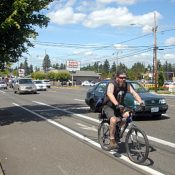
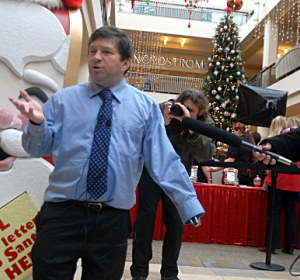

Thanks for reading.
BikePortland has served this community with independent community journalism since 2005. We rely on subscriptions from readers like you to survive. Your financial support is vital in keeping this valuable resource alive and well.
Please subscribe today to strengthen and expand our work.
I think that more needs to be made out of the fact that when Tri-met says frequent service that does not mean that buses come every 15 minutes or less, it means that for more than 1/2 of the time during the week buses are scheduled to come every 15 minutes or less. Many of the lines the buses get so caught up in traffic that what you actually get for much of the peak service period is 2 buses coming together once every 1/2 hour. I think Tri-met needs to start being more serious about delivering the frequent service they are advertising, and that is probably going to require the city and ODOT to allow some bus only lanes.
I am not sure who is to blame, TriMet for advertising Frequent Service or PBOT for preventing the necessary transit priority lanes to take place parking in areas of known congestion. There is nothing TriMet can do to force buses to run on time when they are stuck in the same morass as everyone else.
Read the Enhanced Transit Corridors plan for the identified solutions.
One of the main threats to bicycle safety I have personally experienced biking 122nd and other streets like it is the high amount of car traffic in and out of side businesses. Risks of right hooks into businesses and cars pulling out from businesses way into the bike lane are for some reason much higher on these streets. It’s also common to see drivers use corner business parking lots as short cuts around intersections which greatly endangers bicycles. It seems that one design solution would be to limit the number of entry/exits into strip mall type commercial space which I’m sure will infuriate businesses and drivers alike. Another would be to eliminate street parking around these entry/exits as this is what causes most drivers to pull out so far when exiting.
Whatever the changes, I can’t wait for progress on this.
I avoid this street like the plague on my bike. The current bike lanes are way too narrow. I would actually support a bus/bike lane configuration that would replace all parking on both sides. I’d much rather share the lane with the occasional bus, and this space would allow cyclists and busses to bypass the horrible traffic jams.
Think big! This is a seriously wide street. With parking removal and a road diet, there is totally space for (in order out from the curb) a bike lane, a small median/planter/bus stop island area, a bus lane (with auto use for business access), a car lane each way, and a center turn lane.
Most of the streets east of 82nd were designed by the county to have 3 lanes in each direction without any on-street parking, with all land uses requiring off-street parking, hence all the driveways and curb-cuts. It was only after annexation (1986-1991) that Portland allowed and even encouraged on-street parking. So removing on-street parking shouldn’t be much of an issue for most local residents and businesses – ironically, it’s the City of Portland and its land use policies who will be PBOT’s greatest political obstacle.
Although a reorganization is needed on 122nd, I am not optimistic it will ever happen. There will be a tremendous backlash from residents and businesses against such an idea. I will work for it but I have my doubts. Immediate changes that should happen: more street lighting, hawk lights at crossing and more crossing, lower the speed limit and add cameras, and finally, fix the very messed up intersections. Changes to the intersections could be pedestrian and bike signal priority, and eliminating right turns on red. Other improvements could be eliminating parking to allow for more space for bikes and sidewalk improvements including widening and removing obstacles.
Four- and five-lane roads kill. They are incompatible with Vision Zero. Please take the survey and let the city know that three SOV lanes (one each way and a median turn lane) should be the limit in any reconfiguration. The remaining space can be reallocated for pedestrians, bikes, and buses.
Since I know the curbs and sewers are never going to be removed nor rebuilt at any time in the next 50 years, I’m going to assume that any sidewalk width expansion, currently 7.5 feet on average, will come at the expense of local land owners.
Given that 122nd is essentially a 7-lane width curb-to-curb (75 feet), I’d recommend a medium-term solution of abandoning BRT on Division and moving it to a 122nd, Airport, 82nd, Sandy, Cesar Chavez (39th) and Division loop in both directions. On all streets, parking would be removed, of course, as would all left-turn lanes. For Sandy, Airport, Division & 122nd, I’d use the center 3 lanes exclusively for BRT (express bus on the short-term), with center platforms, using medians to separate it from traffic. The inner 2 lanes on each side would be reconfigured into something similar to outer Burnside, but with buffered bike lanes. Given that 39th, inner Division, and 82nd have a much narrower 4 or 5-lane right-of-way, I’d redesign them to have exclusive bus lanes down the center 2 lanes, but without medians, and with stops along the curbs similar to light rail on 5th & 6th Avenues downtown. Add buffered bike lanes whenever possible.
I agree, dream big.
Road diet. Remove curbside parking. Bus lanes and bike lanes. And – thinking green – lots of street trees, so that this will someday be a pleasant place to walk.
The answer is simple. More greenways = less of the evil “cut through traffic” in neighborhoods. People get excited for road diets on bigger roads but then turn around and cry to the city about cut through. I can’t help but scratch my head and wonder what people in the road diet crowd are thinking. We need policing. Want better drivers? I know, you want less, but in the meantime, either offer better training or enforce the laws. Need a nice example of silly laws without enforce? 20mph. I have yet to see anyone slow down in my neighborhood, Prius’s included.
I enforce the speed limits by driving them. I enforce red light compliance by stopping at the yellows. Other road users get angry. 😉
You should offer a free training.
Absolutely concur with several comments above. I have driven the 73 hundreds (thousands?) of times. I can say anything less than dedicated transit lanes and physically separated bike facilities is nothing but happy talk and paint. The problem is that 122 is a major traffic sewer and has to carry a ton of traffic just like 82nd so reducing throughput will only add to frustration and congestion.
Realistically, the only outcomes I would anticipate out of this exercise are ADA-compliant curb cuts and sidewalks with more mid-block rapid flash crossings, all dressed up in the latest PBOT spin machine propaganda. “Mission Accomplished”
I like the BRT ideas and ditching the on-street parking;
I think we could go a step further and ban left turns on all high-crash corridors. You can pull a U-turn at stop lights and make a right turn to your destination, and it dramatically reduces the left-hook danger.
With no center turn lane or on-street parking, there’s space for a 12 ft sidewalk, 6 ft bike lane, 1 auto lane, and a Lane right of way BRT, going each direction.
I also second the “plant more trees comment.”
I would love to walk or ride down streets in a tunnel of trees; Huge oaks and maples, Giant Sequoias, Blue spuce, groves of Aspens, etc. We have the climate to get creative with plantings, plus it would reduce the urban heat island effect.
A U-turn is simply a more dangerous left turn. To start the U-turn, the car needs to wait until a gap in oncoming traffic is clear, so it blocks a lane unless there is a center lane or left turn pocket. The car then turns across oncoming traffic, creating left hook/cross risk just like a left turn. Then it continues turning to complete the U, so now it is turning across cross-traffic, creating more risk. Larger trucks and tractor-trailers either can’t make the U-turn or have to make a huge sweeping turn during which the driver’s blind spots are increased. U-turns are among the most dangerous maneuvers which is why they are prohibited in many locations.
The permitted U-turns I’ve seen are at stop-lights.
If you are in the left turn lane, you wait for your green and either turn left or pull a U.
glad to see any attention east of 82nd happening.
I took the survey, and I hope that others consider to do so as well. (Link in the post)
Sorry, let me clarify:
Left turns and U-turns only at SIGNALIZED intersections; meaning that you can’t turn across a lane of oncoming traffic anywhere; you continue to an intersection, wait for light with a left turn arrow, wait your turn, and go when there is not oncoming traffic.
No gaps in traffic to jump through.
I don’t know where you’re getting your data about U-turns being more dangerous than direct left turns.
Here’s a Florida Dep. of Transportation study on right turn followed by U-turn as an alternative to direct left turns:
http://www.fdot.gov/research/Completed_Proj/Summary_TE/FDOT_BC353_39_rpt_1.pdf
FDOT findings showed that for 5-7 lane arterials (like 122nd) direct left turns cause a significant number of crashes and conflicts.
Prohibiting direct left turns on or off a roadway and instead allowing right turn then U-turn or U-turn then right turn significantly lowers the number of conflicts AND the severity of conflicts.
As for 18 wheelers, there absolutely should be freight access through major arterials, and PBOT/City of Portland should plan out designated freight routes and loops that don’t get cyclists or pedestrians run over, share those designated routes with freight and trucking companies to get the info to commercial drivers. They shouldn’t be operating in a vacuum.
David Hamptsten is a communist.
I missed the part where he wanted to share your money.
This road is so dangerous. Good to see that someone is taken some kind of action.
I guess no one here drives on 122nd.. the traffic is absolutely herendous, and I can only imagine what a disaster it would be to get rid of half the existing lanes. This plan is one of many reasons I will not stay on the east side.
One of the aims of the road changes is to fix 122nd so it stops killing people. This is arguably more important than letting lots of cars to pass through the area.
Another aim (as seem in option 1C with lane priority for buses) is to give people quick, convenient travel options that aren’t a single occupant car. If more people can get around without the need for driving (or parking) the road doesn’t need to be as wide to move the same number of people.